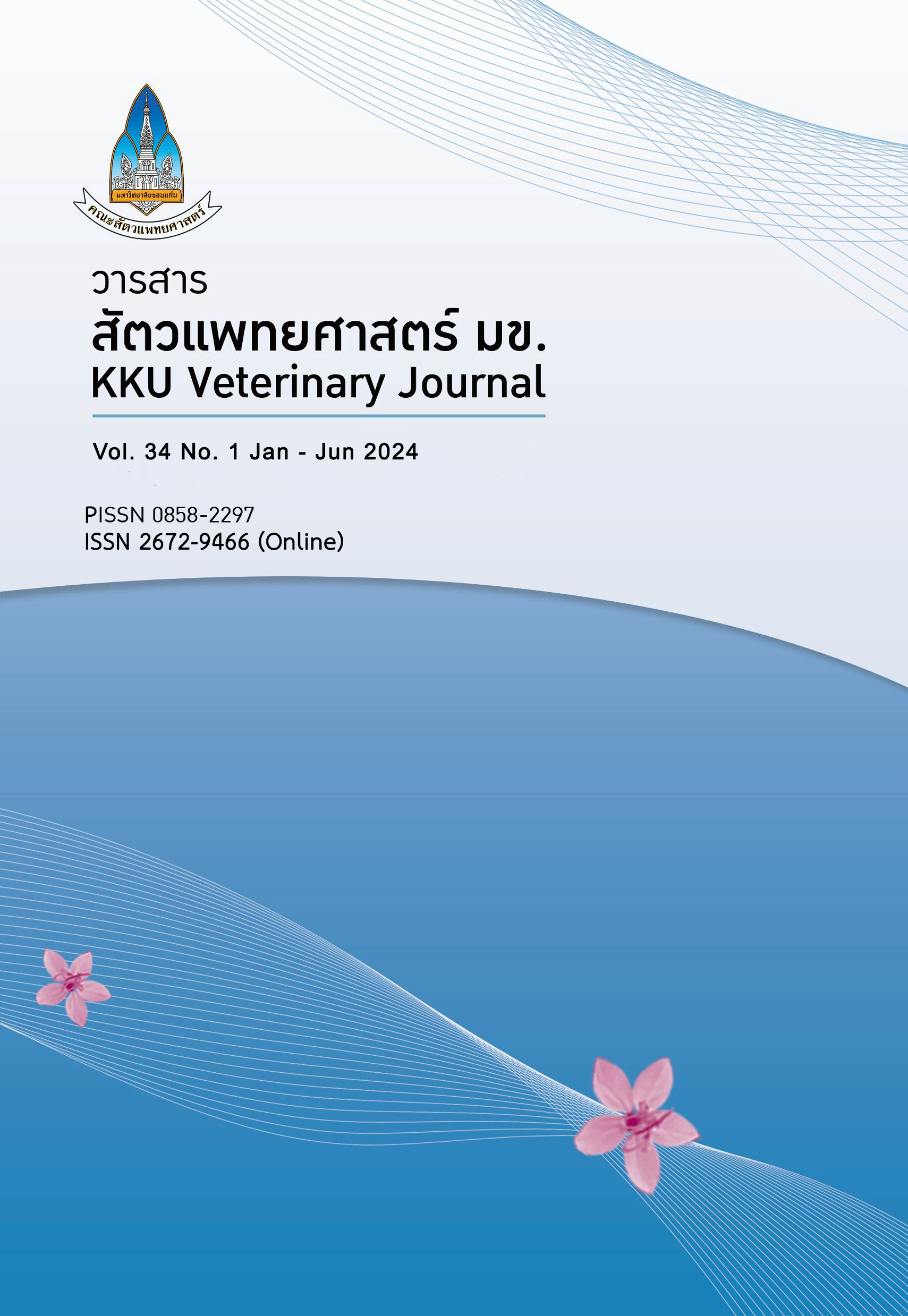คความสัมพันธ์ระหว่างระดับสภาวะอารมณ์กับพฤติกรรมการเลี้ยงลูกหลังคลอด 72 ชั่วโมง ใน โคเนื้อกำแพงแสน
Main Article Content
บทคัดย่อ
วัตถุประสงค์ การศึกษาครั้งนี้มีวัตถุประสงค์เพื่อศึกษาพฤติกรรมและสภาวะอารมณ์ของโคเนื้อระหว่างแม่โคที่มีสภาวะอารมณ์สงบและแม่โคที่มีสภาวะอารมณ์รุนแรงกับพฤติกรรมการเลี้ยงลูก 72 ชั่วโมงหลังคลอด
วัสดุ อุปกรณ์ และวิธีการ การทดลองนี้ศึกษาในโคเนื้อเพศเมียพันธุ์กำแพงแสนจำนวน 16 ตัว อุปกรณ์สำหรับการทดลองประกอบด้วย กล้องบันทึกภาพและวีดีโอ คอมพิวเตอร์โน๊ตบุ๊ค ซองทดสอบอารมณ์ และซองวัดความเร็วออกจากซองบังคับ สำหรับประเมินสภาวะอารมณ์ของโคแต่ละตัวหลังการจัดกลุ่มสภาวะอารมณ์แม่โคจะทำการบันทึกพฤติกรรมตั้งแต่ก่อนคลอด 1 วัน จนถึงหลังคลอด 72 ชั่วโมง และเก็บข้อมูลพฤติกรรมแม่โคแต่ละตัวที่เลี้ยงลูกผ่านไฟล์บันทึกวีดีโอ
ผลการศึกษา ผลการทดสอบอารมณ์โคโดยวิธีทดสอบอารมณ์ในซองบังคับและการวัดความเร็วออกจากซองบังคับ พบว่าคะแนนอารมณ์ระดับต่ำและสูงมีค่าเฉลี่ยเท่ากับ 1.67±0.31 และ 4.00±0.33 คะแนน ตามลำดับ ความเร็วออกจากซองบังคับช้าและเร็วมีค่าเฉลี่ยเท่ากับ 0.21±0.02 m/s และ 0.54±0.19 m/s ตามลำดับ นำผลการทดสอบอารมณ์ในซองบังคับและค่าความเร็วออกจากซองบังคับมาจัดจำแนกกลุ่มโคที่มีอารมณ์สงบและโคที่มีอารมณ์รุนแรง กลุ่มโคอารมณ์สงบ (n=7) และ กลุ่มโคอารมณ์รุนแรง (n=9) ผลการศึกษาพฤติกรรมแม่โคพบว่า แม่โคที่มีอารมณ์สงบมีระยะเวลาตั้งแต่คลอดจนเข้าหาลูกครั้งแรกหลังคลอดช้ากว่าโคกลุ่มอารมณ์รุนแรง 6.57±0.24 วินาที และ 3.66±0.21 วินาที ตามลำดับ แม่โคที่มีอารมณ์รุนแรงมีจำนวนครั้งในการเข้าหาลูกโคหลังคลอด 72 ชั่วโมงมากกว่าแม่โคที่มีอารมณ์สงบ 18.22±0.34 ครั้ง และ 13.28±0.39 ครั้ง ตามลำดับ แต่ระยะเวลาในการเลียกระตุ้นลูกโคหลังคลอด แม่โคที่มีอารมณ์สงบมีระยะเวลาในการเลียกระตุ้นมากกว่าแม่โคที่มีอารมณ์รุนแรง 43.00±0.88 นาที และ 37.55±0.77 ตามลำดับ
สรุป สภาวะอารมณ์ของแม่โคแต่ละตัวที่แตกต่างกันส่งผลให้การแสดงพฤติกรรมในการเลี้ยงลูกแตกต่างกัน เช่น ระยะเวลาตั้งแต่คลอดจนเข้าหาลูกครั้งแรกหลังคลอด พฤติกรรมการเลียกระตุ้นลูกโค และจำนวนครั้งในการเข้าหาลูกโค ซึ่งพฤติกรรมดังกล่าวสามารถแสดงถึงความเป็นแม่ของแม่โคที่จะสามารถเลี้ยงลูกหลังคลอดให้มีสุขภาพที่ดีหลังคลอด ดังนั้นการรู้และทราบถึงสภาวะอารมณ์ของแม่โคแต่ละตัวจะทำให้สามารถจัดการแม่โคแต่ละตัวได้ดีมากขึ้นเพื่อลดปัจจัยและความเสี่ยงภายในฟาร์มที่ส่งผลต่อสภาวะอารณ์และพฤติกรรมแม่โคในช่วงเลี้ยงลูกได้
Article Details

This work is licensed under a Creative Commons Attribution-NonCommercial-NoDerivatives 4.0 International License.
References
Beckman DW, Enns RM, Speidel SE, Brigham BW, Garrick DJ, 2007. Maternal effects on docility in limousin cattle. J Anim Sci 85, 650-657.
Behrends SM, Miller RK, Rouquette FM, Randel RD, Warrington BG, Forbes TD, Welsh TH, Lippke H, Behrends JM, Carstens GE, Holloway JW, 2009. Relationship of temperament, growth, carcass characteristics and tenderness in beef steers. Meat Sci 81, 433-438.
Brown RS, Aoki M, Ladyman SR, Phillipps HR, Wyatt A, Boehm U, Grattan DR, 2017. Prolactin action in the medial preopticarea is necessary for postpartum maternal nursing behavior. Proc Natl Acad Sci USA 114, 10779–10784.
Bruno KA, Vanzant ES, Vanzant KA, McLeod KR, 2016. Relationships of a novel objective chute score and exit velocity with growth performance of receiving cattle. J Appl Anim Sci 94, 4819-4831.
Chenoweth PJ, Landaeta Hernandez AJ, Floercke C, 2014. Reproductive and maternal behavior of livestock. In Genetics and the Behavior of Domestic Animals Elsevier Amsterdam The Netherlands, 159–194.
Curley KO, Paschal JRJC, Welsh TH, Randel RD, 2006. Technical note: Exit velocity as a measure of cattle temperament is repeatable and associated with serum concentration of cortisol in brahman bulls. J Appl Anim Sci 84, 31-38.
Dwyer C, 2003. Behavioural development in the neonatal lamb: Effect of maternal and birth-related factors. Theriogenology 59, 1027–1050.
Francisco CL, Cooke RF, Marques RS, Mills RR, Bohnert DW, 2012. Effects of temperament and acclimation to handling on feedlot performance of bos taurus feeder cattle originated from a rangeland-based cow-calf system. J Appl Anim Sci 90, 5067-5077.
Geburt K, Friedrich M, Piechotta M, Gauly M, von Borstel UK, 2015. Validity of physiological biomarkers for maternal behavior in cows-A comparison of beef and dairy cattle. Physiol Behav 139, 361- 368.
Hoppe S, Brandt HR, Konig S, Erhardt G, Gauly M, 2010. Temperament traits of beef calves measured under field conditions and their relationships to performance. J Anim Sci 88, 1982-1989.
Hogan LA, McGowan MR, Johnston SD, Lisle AT, Schooley K, 2022. Suckling Behaviour of Beef Calves during the First Five Days Postpartum. Ruminants 2, 321–340.
Kour H, Patison KP, Corbet NJ, Swain DL, 2021 Recording cattle maternal behaviour using proximity loggers and tri-axial accelerometers. Appl Anim Behav Sci 240, 105-349.
Michenet A, Saintilan R, Venot E, Phocas F, 2016. Insights into the genetic variation of maternal behavior and suckling performance of continental beef cows. Genet Sel Evol 48, 1–12.
Meagher RK, Beaver A, Weary DM, von Keyserlingk MA, 2019. Invited A systematic of the effects of prolongedcow–calf contact on behavior, welfare, and productivity. J Dairy Sci 102, 5765–5783
Michael S, Reagan N, Jeremy P, Beth K, Andrew P, Janeen L, Paul B, 2023. Association of maternal temperament and offspring disposition on growth performance. Translational Animal Science 7, 1–9
Perez L, Orihuela A, Corro M, Rubio I, Cohen A, Galina CS, 2014. Maternal protective behavior of zebu type cattle (bos indicus) and its association with temperament. J Anim Sci 92, 4694-4700
Pornthep P, Jamroen T, Panwadee S, 2022. Measurement of temperament using chute test and exit velocity test in beef cattle. KKU Veterinary Journal 32, 93-98.
Rutherford W, Parish J, Smith T, Vann R, Strickland B, 2018. Effects of maternal behavior of crossbred beef cows at calving onadjusted 205-day calf weaning weights. J Anim Sci 96, 106.
Swain DL, Patison K, Heath B, Bishop-Hurley G, Finger A, 2015, Pregnant cattle associations and links to maternal reciprocity. Appl Anim Behav Sci 168, 10–17.
SAS, 2014. University-edition, sas institute inc, cary, north carolina.
Turner SP, Jack MC, Lawrence AB, 2014. Precalving temperament and maternal defensiveness are independent traits but precalving fear may impact calf growth. J Anim Sci 91, 4417-4425.
Von Keyserlingk MAG, and Weary DM, 2007. Maternal behavior in cattle. Horm Behav 52, 106-113.

